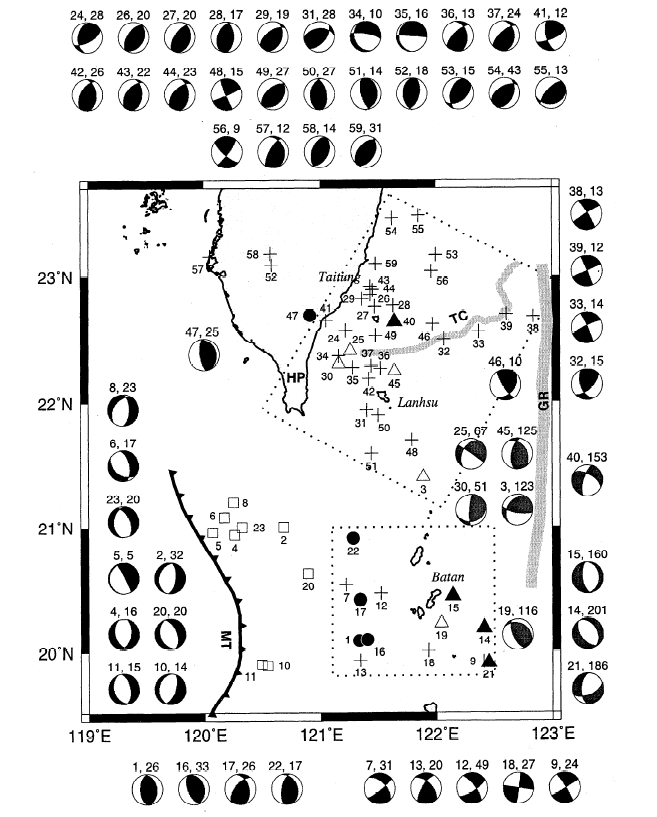Honn Kao1, Gwo-Ching Huang1, and Char-Shine Liu2
1.Institute
of Earth Sciences, Academia Sinica, Taipei, Taiwan
2.Institute of Oceanography, Nation Taiwan University, Taipei, Taiwan
ABSTRACT
We systematically study
the detailed bathymetry, seismicity, and source parameters of large- and moderate-sized
earthquakes that occurred in the northern Luzon arc-Taiwan region between 1964
and 1996. The purpose is to characterize the transition from oblique subduction
to regional collision in terms of the distribution of morphological features,
the characteristics of seismogenic structures, and the corresponding state of
strain. To the south of 21.5![]() N,
the existence of a subduction zone is clearly shown by both bathymetry and seismicity.
The subducted Eurasia slab reaches a maximum depth of ~200 km, and the depth
decreases sharply as it approaches Taiwan. Focal mechanisms indicate that the
subducted slab is in downdip extension for depths <150 km but switches to
downdip compression at greater depths. To the north of 23
N,
the existence of a subduction zone is clearly shown by both bathymetry and seismicity.
The subducted Eurasia slab reaches a maximum depth of ~200 km, and the depth
decreases sharply as it approaches Taiwan. Focal mechanisms indicate that the
subducted slab is in downdip extension for depths <150 km but switches to
downdip compression at greater depths. To the north of 23![]() N,
collision is clearly the predominant process with broad deformation on both
sides of the suture. In between, the transition is accommodated by a distributed
thrust deformation zone in the frontal portion of the accretionary prism, closure
of the forearc basin, and the right-lateral NE-SW striking Taitung canyon fault
zone (TCFZ). These structures resolve the differential movements between the
subduction and collision zones and will repeatedly change their positions as
the collision propagates southwestward. The present-day plate boundary follows
the axis of the Manila trench in the south, broadens significantly in the zone
of transition, and finally becomes a zone of several tens of kilometers in width
across eastern Taiwan. The deformation front, on the other hands, is located
between the Western Foothills and Coastal plain in Taiwan, then connects to
the Manila trench to the south. Seismic strain tensors indicate the region to
the north of TCFZ has a compression rate ~15 times larger than that to the south.
The northern Luzon arc shows characteristics of oblique subduction, but the
effects of collision are not as significant within the subducted Eurasian lithosphere,
as comparing to the subducted Philippine Sea plate beneath the southernmost
Ryukyu arc.
N,
collision is clearly the predominant process with broad deformation on both
sides of the suture. In between, the transition is accommodated by a distributed
thrust deformation zone in the frontal portion of the accretionary prism, closure
of the forearc basin, and the right-lateral NE-SW striking Taitung canyon fault
zone (TCFZ). These structures resolve the differential movements between the
subduction and collision zones and will repeatedly change their positions as
the collision propagates southwestward. The present-day plate boundary follows
the axis of the Manila trench in the south, broadens significantly in the zone
of transition, and finally becomes a zone of several tens of kilometers in width
across eastern Taiwan. The deformation front, on the other hands, is located
between the Western Foothills and Coastal plain in Taiwan, then connects to
the Manila trench to the south. Seismic strain tensors indicate the region to
the north of TCFZ has a compression rate ~15 times larger than that to the south.
The northern Luzon arc shows characteristics of oblique subduction, but the
effects of collision are not as significant within the subducted Eurasian lithosphere,
as comparing to the subducted Philippine Sea plate beneath the southernmost
Ryukyu arc.
